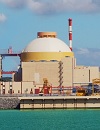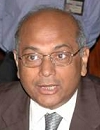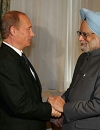India
Indian diplomats visited Izhora Plant and LNPP
Alexey Likhachev and Ajit Kumar Mohanty visited the construction site of the first IV generation energy complex
414 nuclear units are operating in the world, 57 units are under construction
 PFBR-500 - start of fuel loading
PFBR-500 - start of fuel loading
Fuel loading into the reactor core will begin today at the PFBR unit under construction in India - also known as PFBR-500, a demonstration unit with a fast sodium reactor.
Indian Prime Minister Narendra Modi, who is visiting Tamil Nadu, intends to observe the start of the fuel loading, as reported in the Indian media.
Marking a historic milestone in India's nuclear power programme, Prime Minister will witness the initiation of core loading of India's indigenous Prototype Fast Breeder Reactor(PFBR) of 500 MWe capacity at Kalpakkam, Tamil Nadu, a government press release said.
The text of the release recalls that the reactor project was developed by the Indian company BHAVINI.
NPCIL may consider PHWR-220 construction
ROSATOM took part in INSIC-2023 conference in Mumbai (India)
KAPP-4 achieves first criticality
Kakrapar-3 unit has been put into commercial operation
Welding of the main coolant pipeline has commenced at Kudankulam NPP Unit 3
Reactor building dome has been installed in design position at Kudankulam NPP Unit 3
 TVEL unveils new fuel solutions for the Indian market
TVEL unveils new fuel solutions for the Indian market
In 2022, TVEL started exports of the more advanced TVS-2M fuel to India, instead of the UTVS model, previously supplied to Kudankulam. Introduction of the new fuel enables elongation of the reactors operation between refuelings form 12 to 18 months, which would essentially enhance the power plants performance and economic efficiency (besides, TVS-2M model is more reliable). However, the new Rosatom developments have a potential to make the further operations of the power plant, lasting for decades, even more efficient.
Alexander Ugryumov stressed, that introduction of nuclear fuel with enrichment over the 5% level will enable operations of VVER-1000 reactors in longer 24 months fuel cycles. Extending the fuel cycle means that a power...
 India - turtle pace
India - turtle pace
The largest project in the Indian nuclear power industry is a plan for the fleet mode construction of ten power units with PHWR-700 reactors, or IPHWR-700 (Indian PHWR), as they are called in India.
Nuclear companies have started contracting equipment for the future fleet, but the construction start dates are constantly shifting to the right. In addition, the start of the head unit (not included in the series!) with the IPHWR-700 is difficult.
The role of the head unit went to unit No. 3 of the Kakrapar NPP. It began to be built in November 2010 and was first synchronized with the grid only in January 2021.
It was expected that the unit would be put into commercial operation in March 2021. In reality, Kakrapar-3 has not...
Reactor vessel is installed on Unit No. 3 of Kudankulam NPP
 Kudankulam: AFR controversy continues
Kudankulam: AFR controversy continues
The conflict over the proposed dry storage facilities for spent nuclear fuel from the Kudankulam nuclear power plant (India) has reached a new level.
The local authorities, who oppose the storage facilities, are calling for the central government to join the discussion and either return the spent nuclear fuel to Russia or place it in a permanent geological storage facility, which, by the way, is not available in India.
Recall that in 1998, when signing an agreement with Russia on the construction of the Kudankulam nuclear power plant, the Indian side insisted that the spent nuclear fuel would remain in India for processing.
Prior to being sent for reprocessing, the plant irradiated fuel is stored in spent fuel pools, from where it is planned...
Nuclear News Ticker - February 27, 2021
444 nuclear units are operating in the world, 51 units are under construction
 TVEL will introduce new fuel and extended fuel cycle at Kudankulam NPP
TVEL will introduce new fuel and extended fuel cycle at Kudankulam NPP
Compared to the UTVS fuel model, which is currently supplied to Kudankulam NPP, TVS-2M fuel assemblies have a number of advantages making them more reliable and cost-effective.
First, it is the rigidity of a bundle: because of the welded frame, the fuel assemblies in the reactor core retain their geometry, the spacer grids protect fuel rod cladding from fretting wear (preventing from depressurization), and the additional spacer grid makes fuel assemblies more vibration-resistant.
Secondly, the new fuel has increased uranium capacity - one TVS-2M assembly contains 7.6% more fuel material as compared to UTVS.
Everything that we offer to our Indian partners is focused...
Nuclear News Ticker - November 28, 2020
Installation of Reactor Pressure Vessel Dry Shielding Completed on Kudankulam NPP Unit 3 (India)
TVEL completes the contract for supply of fuel pellets to India for Tarapur NPP
TVEL to supply fuel pellets for Tarapur NPP in India
Unit 1 of the Kaiga NPP (India) completed 900 days of the continuous operation
The second Russian NPPs in India may appear in Andhra Pradesh or Karnataka
The party-member of the ruling coalition in India opposes Jaitapur nuclear power plant
India started to create a project of its own 900 MWe light water reactor
Kudankulam-1 was put into commercial operation
The number of nuclear facilities under IAEA safeguards in India will increase to 22
Kudankulam-3/4 construction shall start on 2015-2016
India imported 4458 tons of uranium since 2008
Agreement on the construction of the third and fourth units of Kudankulam is signed
India does not disclose uranium annual production
Experts rectify the malfunctions of the Kudankulam NPP turbine
India Conducts First Successful Test of Nuclear-Capable Cruise Missile: Reports
Australia-India Uranium Deal Disregards Nuclear Safeguards: Former Nuclear Watchdog Head
Russia, India Discuss Construction of New Units at Kudankulam Nuclear Power Plant
Russian, Indian Nuclear Experts to Hold Consultations on Prospects of Cooperation
Second Unit of India Kudankulam Power Plant Set to Open in November
Abbott Likely to Sign Australia-India Uranium Deal During New Delhi Visit
India, Russia Start Naval Drills in Sea of Japan
Russia, India to Hold Naval Exercises in Sea of Japan
Putin Discusses Top-Level Cooperation With New Indian Prime Minister
Putin Expects Stronger Relations With India After Opposition Win
Russian-Designed Reactor at Indian Nuclear Plant Nears Capacity Ц Source
Russia Prepared to Modify Submarines for Indian Tender
India Test Fires New Agni-IV Ballistic Missile
Russia, India to Hold Joint Naval Drills in Sea of Japan
India Looks to Russia as Provider of Future Energy Security
Indian Premier Arrives in Moscow For Summit
Indian PM Praises Russia for Assistance in Nuclear Energy Development
India Conducts Second Test of Agni-5 Missile
Japan, India to Go Ahead with Nuclear Talks
India Claims Problems With Russian-Leased Nuclear Sub
India to Complete 2nd NPP Unit in 2013 - Prime Minister
Russian-Indian Nuclear Project On Track - Nuclear Chief
Moscow: Foreign NGOs Behind India NPP Protests
India Modifies Brahmos Missile With New Nav System
Nuclear Fuel to be Loaded in Kudankulam Power Plant
Russia, India Agree Additional Kudankulam NPP Financing
India Tests Nuclear-Capable Ballistic Missile
India to Induct Russian Nerpa Nuclear Sub on Wed.
India to Deploy Two Nuclear Submarines
Russians Resume Work at Indian Nuclear Project
Russian Nuclear Sub to Arrive in India on March 30-31
Russia Hands Over Nerpa Nuclear Sub to India
Russia to hand over nuclear sub to India in January
India, Pakistan exchange lists of nuclear data
Russian nuclear sub ready for India transfer
Russia to lease Nerpa nuclear submarine to India by yearend
First unit of Kudankulam nuclear plant may be launched in next 2 weeks - Indian PM
Russia, India to sign energy, warplane deals
Indian PM to visit Russia
 Indian decision to stop nuclear program may trigger problems
Indian decision to stop nuclear program may trigger problems
India is experiencing a wave of protests against the construction of Russian nuclear power plants. Public fears, fuelled by the Fukushima accident and exacerbated by the regional politicians populist slogans, may provoke a chain reaction of problems, hampering power generation development and depriving the Indian economy of its critical advantages over China.
Russian and Indian nuclear experts cannot meet to discuss the launch of Kudankulam NPP first unit because of public protests, Alexander Glukhov, the head of the Russian contractor, Atomstroyexport, told the media. This could set back the deadline for the launch of the plant, which is being built with Russian assistance.
Tensions in Tamil Nadu, where the nuclear power plant is being built, started growing early this year and resulted in a public blockade of the construction site by local public activists in the fall. They are protesting for environmental reasons, and their concerns have only grown following the Fukushima tragedy in Japan. Unsure of what would happen next, the Indian regulators are procrastinating with the issue of permits to commission the power plant.
Protests over Indo-Russian nuclear plant suspended for elections
Protesters stop construction of Indo-Russian nuclear plant
Financial loss after Fukushima disaster estimated at $74 billion
Russia to lease troubled nuclear sub to India in November
Russia set to take part in new Indian submarine tender
India to get Russian Nerpa submarine by yearend
India pushes for nuclear triad - paper
Kazakhstan, India sign energy deals
India successfully test-fires ballistic missile interceptor
Representatives of Walchandnagar Industries Ltd. (India) visited AEM-Technologies and Petrozavodskmash
Russia, India to develop new generation reactors
Russia to cooperate with India on energy, pharmaceuticals
Dmitry Medvedev to head to India
Rosatom offers India cooperation in development of uranium deposits
India building reactors for nuclear submarines
India still 'hopeful' about nuclear plant despite Russian calls for relocation - paper
India, U.S. sign nuclear energy agreement - news agency
India allocates $11 bln to build six new submarines - paper
Tvel nuclear fuel company takes part in India exhibition
India to get Russian nuclear submarine for 10-year lease - paper
India could offer new NPP construction site to Russia
India may join Russia in establishing Angarsk nuclear fuel bank
 Indian nuclear energy chief: Russia has an advantage: it has a reactor, others can only show papers
Indian nuclear energy chief: Russia has an advantage: it has a reactor, others can only show papers
How interesting is the Russian offer to India to become a stakeholder in the Angarsk facility?
India is interested as a donor country. And we are looking into it. It is attractive, but requires a very detailed techno commercial dealings which have not been completed.
We have to evaluate the facility, and economics here comes as a major factor. It is not just a political arrangement.
So I cannot straight away say that India is joining just now, but India has a capability of joining as an equal partner in some of these activities.
What do you think about an international market of plutonium for peaceful use in the energy sector? Is this a realistic perspective?
This question is a bit early today. Eventually India may be in a position to provide plutonium to other countries, but today our programme does not have so much plutonium to provide it to international market. This will require a very stringent material accounting system, safeguarding system, and safeguard veryfication system. That is why this question is a little premature.
India seeks greater nuclear cooperation with Russia - official
Russia close to finishing reactor at Indian nuclear power plant
 Indian Prime Minister Manmohan Singh interview to Russian media
Indian Prime Minister Manmohan Singh interview to Russian media
Indian economy is showing a very impressive growth. Quarterly figures have proved it. When do you expect the economy of India to rebound, recover from the global crisis which has affected it and to reach the desired level of nine per cent annual growth?
Indian economy has been affected by the global slowdown. Before the global slow down our economy in the previous four years was increasing at an annual rate of nine per cent per annum. Last year, because of the global slowdown the growth rate declined to about 6.7 per cent. This year we expect the growth rate to be 6.5 to seven per cent. In two to three years time, I am confident that the Indian economy can bounce back to the growth rate of about nine per cent per annum. I say this for many reasons. Our savings rate is about 35 per cent of our GDP. Our investment rate is about 37 per cent of GDP. With these savings rate and investment rates, we can sustain a growth rate of nine per cent without difficulty. With an investment of 37 per cent and the capital output ratio of four is to one we can easily attain the targeted growth rate of nine per cent per annum, which I expect we will do.
Indian NPP workers get radiation dose from contaminated water
Russia, India, China set to forge energy ties
JSC TVEL supplied the first batch of natural uranium pellets for Indian Pressurized Heavy Water Reactors
 Nuclear deal between India and USA has arisen from the dead
Nuclear deal between India and USA has arisen from the dead
India has made the first step to escape an international nuclear isolation. Government of this country has enlisted the support of the regional socialistic party Samajwadi in the parliament. Now there is no threat of the no-confidence vote to the cabinet of ministers, and government can begin realizing final steps of the nuclear deal with the USA.
Certainly, Amar Singh, Samajwadi general-secretary assures journalists that his party won't change its negative attitude to the nuclear deal until the government, or precisely prime-minister Manmohan Singh - won't give public answers to the questions of the left political parties.
Though, even if the declaration of the cabinet chief will follow, it won't have any juridical liabilities. According to the Indian constitution deputies don't have a right to ratify international agreements and the only thing that government was afraid of, was a possibility of the liable parliament coalition split. After the appearance of Samajwadi such a thread was definitely eliminated.
Frozen opening
Nuclear renaissance requires sacrifices. But if in far African Niger real blood runs in the struggle for uranium, in India more close to us only the fate of Cabinet of Ministers has been sacrificed at the altar of peaceful atom. Junior partners of Indian government from left parties have blocked a passage of so-called nuclear deal between India and USA, having recourse to threat of ahead-of schedule election.
Indian press harried to name negative reaction of Russia on this event. The largest newspapers of Asian democracy note that Sergey Lavrov demonstratively refused to meet with its Indian colleague arrived to Moscow with official visit. The complaint of the Russians is that Russia expected to conclude several profitable contracts for construction of NPPs in India - of course, only in the case, if India-USA nuclear deal is going its way.
Izhorsk plants have completed the 37th shipment for Kudankulam NPP
Kaiga atomic plant to go critical by month end
Belarus to start building its first nuclear power plant in 2008
Belarus plans to start building its first nuclear power plant in 2008. Belarus's National Academy of Sciences said Monday the NPP's first unit will be commissioned in 2013-2014, and the second unit by 2015. Their total power will be 1,000 megawatts. Another two units will be built by 2025. Earlier, a deputy chairman of the academy presidium, Vladimir Timoshpolsky, said Russia and France are the likeliest partners of Belarus in the project.
Gref: outlook for Indo-Russian trade and economic cooperation
What units is Russia going to build on new Indian sites? These will be VVER-1000 reactors (a 1,000 MW water-cooled reactor), which use the most up to date technology in the nuclear industry. As many as 52 such units are already operating successfully, 14 of them in Russia. Their service life is over 1,000 reactor-years. According to independent experts and the IAEA, the Russian VVER-1000 is one of the most reliable reactors in the world. Its safety is comparable to NPPs in Europe, the Unites States and Japan. At the same time, the price to quality ratio makes the Russian reactors superior to their foreign analogues.
Russia set to launch first unit of NPP in India in 2008
Kaiga 3rd reactor unit nearing completion
Apsara to get new indigenous core
BHEL plans JV with Alstom for nuke project












